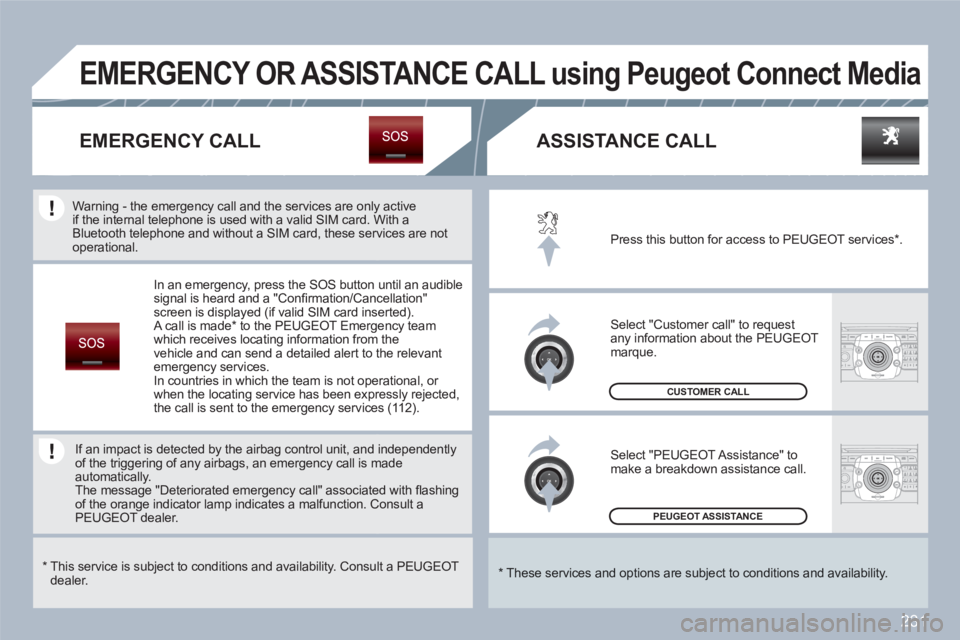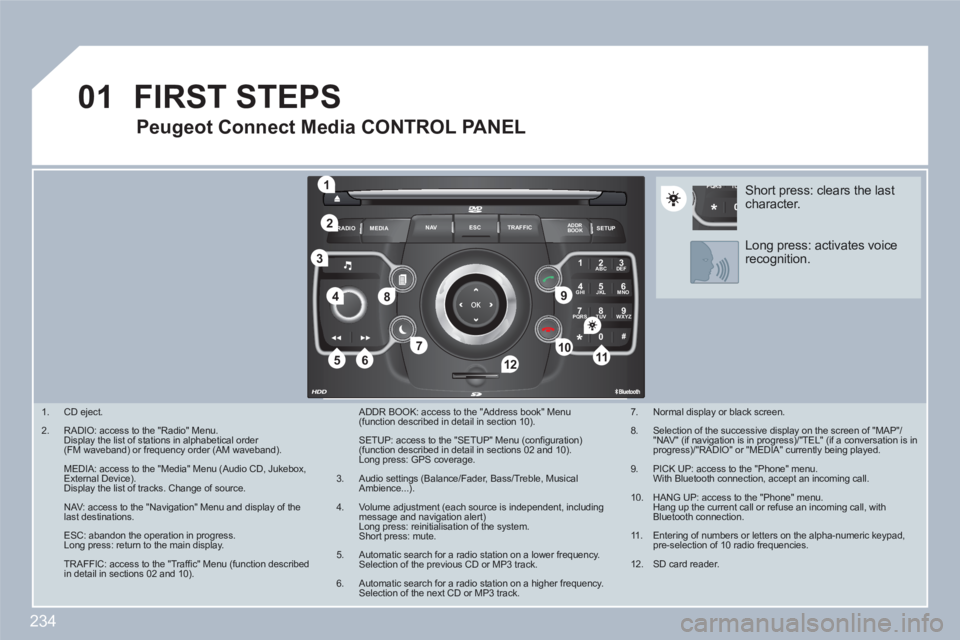2010 PEUGEOT 308 SW BL display
[x] Cancel search: displayPage 154 of 336

i
152
DRIVING
CRUISE CONTROL
System which automatically maintains
the speed of the vehicle at the value
programmed by the driver, without any
action on the accelerator pedal.
The cruise control is switched on
manually: it requires a minimum vehi-
cle speed of 25 mph (40 km/h) and the
engaging:
- of fourth gear on the manual gearbox,
- of second gear on the electronic
gear control gearbox or automatic
gearbox, in sequential driving mode,
- of position A
on the electronic
gear control gearbox or D
on the
automatic gearbox. The controls of this system are grouped
together on stalk A
.
1.
Cruise control mode selection dial
2.
Speed programming/programmed
value decrease button
3.
Speed programming/programmed
value increase button
4.
Cruise control off/resume button The programmed information is grouped
together on the instrument panel dis-
play.
5.
Cruise control off/resume indication
6.
Cruise control mode selection indi-
cation
7.
Programmed speed value
Steering mounted controls
Displays on the instrument panel
The cruise control cannot, in any
circumstances, replace the need
to observe speed limits, nor can it
replace the need for vigilance and
responsibility on the part of the
driver. The cruise control is switched off
man-
ually or by pressing the brake or clutch
pedal or on triggering of the ESP sys-
tem for safety reasons.
It is possible to exceed the programmed
speed temporarily by pressing the ac-
celerator pedal.
To return to the programmed speed,
simply release the accelerator pedal.
Switching off the ignition cancels any
programmed speed value.
Page 155 of 336

!
DRIVING
When the cruise control is switched
on, be careful if you maintain the
pressure on one of the programmed
speed changing buttons: this may
result in a very rapid change in the
speed of your vehicle.
Do not use the cruise control on
slippery roads or in heavy traffi c.
On a steep descent, the cruise
control will not be able to prevent
the vehicle from exceeding the pro-
grammed speed.
To avoid any risk of jamming of the
pedals:
- ensure that the mat is positioned
correctly,
- never fi t one mat on top of
another.
Programming
�)
Turn dial 1
to the "CRUISE"
position: the cruise control mode
is selected but is not switched on
(OFF).
Exceeding the programmed speed
Intentional or unintentional exceeding of the programmed
speed results in fl ashing of this speed on the display.
Return to the programmed speed, by means of intentional
or unintentional deceleration of the vehicle, automatically
cancels the fl ashing of the speed.
Return to normal driving
�)
Turn dial 1
to the "0"
position: the cruise control mode
is deselected. The display returns to the distance
recorder.
Operating fault
In the event of a cruise control malfunc-
tion, the speed is cleared resulting in
fl ashing of the dashes.
Have it checked by a PEUGEOT dealer.
�)
Set the programmed speed by
accelerating to the required
speed, then press button 2
or 3
(e.g.: 70 mph (110 km/h)).
�)
Switch off the cruise control by pressing button 4
: the
display confi rms that it has been switched off (OFF).
�)
Switch the cruise control back on by pressing button 4
again.
You can then change the programmed speed using but-
tons 2
and 3
:
- by + or - 1 mph (km/h) = short press,
- by + or - 5 mph (km/h) = long press,
- in steps of + or - 5 mph (km/h) = maintained press.
Page 156 of 336

!
154
DRIVING
PARKING SENSORS
This system indicates the proximity
of an obstacle (person, vehicle, tree,
gate, etc.) which comes within the fi eld
of detection of sensors located in the
bumper.
Certain types of obstacle (stake, road-
works cone, etc.) detected initially will
no longer be detected at the end of the
manoeuvre due to the presence of blind
spots.
This function cannot, in any cir-
cumstances, take the place of the
vigilance and responsibility of the
driver.
Rear parking sensors
The system is switched on by engaging
reverse gear. This is accompanied by
an audible signal.
The system is switched off when you
exit reverse gear.
Audible assistance
The proximity information is given by
a discontinuous audible signal, the fre-
quency of which increases as the vehicle
approaches the obstacle.
The sound emitted by the speaker (right
or left) indicates the side on which the
obstacle is located.
When the distance between the vehicle
and the obstacle becomes less than ap-
proximately thirty centimetres, the audi-
ble signal becomes continuous.
This supplements the audible signal by
displaying segments on the multifunc-
tion screen which move progressively
nearer to the vehicle. When the obsta-
cle is near, the symbol "Danger" is also
displayed on the screen.
Visual assistance
Page 157 of 336

ii
155
DRIVING
Front parking sensors
In addition to the rear parking sensors,
the front parking sensors are triggered
when an obstacle is detected in front
and the speed of the vehicle is still
below 6 mph (10 km/h).
The sound emitted by the speaker (front
or rear) indicates whether the obstacle
is in front or behind.
The front parking sensors are interrupted
if the vehicle stops for more than three
seconds in forward gear, if no further ob-
stacles are detected or when the speed
of the vehicle exceeds 6 mph (10 km/h).
Deactivation/Activation of the front
and rear parking sensors
Deactivation/Activation of the rear
parking sensors
The function will be deactivated au-
tomatically if a trailer is being towed
or a bicycle carrier is fi tted (vehicle
fi tted with a towbar or bicycle car-
rier recommended by PEUGEOT).
Operating fault
In bad weather or in winter, ensure
that the sensors are not covered
with mud, ice or snow. When re-
verse gear is engaged, an audible
signal (long bleep) indicates that
the sensors may be dirty.
When the vehicle is moving at a
speed below 6 mph (10 km/h), cer-
tain sound sources (motorcycle,
lorry, pneumatic drill, etc.) may trig-
ger the audible signals of the park-
ing sensor system.
The function is deactivated by pressing
this button. The indicator lamp on the
button comes on.
Pressing this button again reactivates
the function. The indicator lamp on the
button switches off.
The function is deactivated
or activated via the multi-
function screen confi gura-
tion menu.
The status of the function
is stored when the ignition
is switched off.
For further details about the access to
the parking sensors menu, refer to the
vehicle confi guration section corre-
sponding to your multifunction screen.
If an operating fault occurs,
when reverse gear is engaged
this warning lamp is displayed
on the instrument panel and/or
a message appears on the screen, ac-
companied by an audible signal (short
bleep).
Consult a PEUGEOT dealer.
Page 190 of 336

1
188
PRACTICAL INFORMATION
Fuse N°
Rating
Functions
G36
30 A
Driver and passenger heated seats.
G37
5 A
Driving position memory unit, lighting rheostat.
G38
30 A
Driver’s seat memory unit.
G39
30 A
Trailer fusebox supply.
G40
-
Not used.
Fuse N°
Rating
Functions
F12
15 A
Instrument panel, seat belt and passenger’s front
airbag warning lamps display, air conditioning,
driver’s seat memory unit, 2nd row rear seat
switches, driving school module.
F13
5 A
Engine fusebox, airbags, electronic gear control
gearbox gear lever, trailer fusebox.
F14
15 A
Multifunction screen, amplifi er, Bluetooth system,
rain/brightness sensor, parking sensors control
unit.
F15
30 A
Locking and deadlocking.
F17
40 A
Rear screen and door mirrors defrosting.
SH
-
PARC shunt.
Page 233 of 336

231
2ABC3DEF5JKL4GHI6MNO8TUV7PQRS9WXYZ0*#
1RADIOMEDIANAVESCTRAFFICSETUPADDRBOOK
2ABC3DEF5JKL4GHI6MNO8TUV7PQRS9WXYZ0*#
1RADIOMEDIANAVESCTRAFFICSETUPADDRBOOK
PEUGEOT ASSISTANCE
CUSTOMER CALL
Press this button for access to PEUGEOT services * .
Select "Customer call" to request any information about the PEUGEOTmarque.
Select "PEUGEOT Assistance" to make a breakdown assistance call.
* These services and options are subject to conditions and availability.
EMERGENCY CALL
EMERGENCY OR ASSISTANCE CALL using Peugeot Connect Media
ASSISTANCE CALL
In an emergency, press the SOS button until an audible signal is heard and a "Confi rmation/Cancellation"screen is displayed (if valid SIM card inserted). A call is made *
to thePEUGEOT Emergency team Twhich receives locating information from the vehicle and can send a detailed alert to the relevant emergency services.
In countries in which the team is not operational, or when the locating service has been expressly rejected, the call is sent to the emergency services (11 2).
If an impact is detected by the airbag control unit, and independentlyof the triggering of any airbags, an emergency call is mmade automatically.
The message "Deteriorated emergency call" associateed with fl ashingof the orange indicator lamp indicates a malfunction. CConsult aPEUGEOT dealer.
Warning - the emergency call and the services are onlyy activeif the internal telephone is used with a valid SIM card. WWith aBluetooth telephone and without a SIM card, these serrvices are notoperational.
*
This service is subject to conditions and availability. Consult a PEUGEOTdealer.
Page 236 of 336

234
01
2ABC3DEF
5JKL4GHI6MNO
8TUV7PQRS9WXYZ
0*#
1
RADIO MEDIANAV ESC TRAFFIC
SETUPADDR
BOOK
1
10
2
3
4
612
9
7
8
115
TU PQRS
0*
1.
CD eject.
2.
RADIO: access to the "Radio" Menu. Display the list of stations in alphabetical order (FM waveband) or frequency order (AM waveband).
MEDIA: access to the "Media" Menu (Audio CD, Jukebox, External Device). Display the list of tracks. Change of source.
NAV: access to the "Navigation" Menu and display of thelast destinations.
ESC: abandon the operation in progress. Long press: return to the main display.
TRAFFIC: access to the "Traffi c" Menu (function describedin detail in sections 02 and 10).
ADDR BOOK: access to the "Address book" Menu (function described in detail in section 10).
SETUP: access to the "SETUP" Menu (confi guration) (function described in detail in sections 02 and 10). Long press: GPS coverage.
3.
Audio settings (Balance/Fader, Bass/Treble, MusicalAmbience...).
4.
Volume adjustment (each source is independent, including message and navigation alert) Long press: reinitialisation of the system. Short press: mute.
5.
Automatic search for a radio station on a lower frequency. Selection of the previous CD or MP3 track.
6.
Automatic search for a radio station on a higher frequency. Selection of the next CD or MP3 track.
FIRST STEPS
Peugeot Connect Media CONTROL PANEL
7.
Normal display or black screen.
8.
Selection of the successive display on the screen of "MAP"/"NAV" (if navigation is in progress)/"TEL" (if a conversation is inprogress)/"RADIO" or "MEDIA" currently being played.
9.
PICK UP: access to the "Phone" menu. With Bluetooth connection, accept an incoming call.
10.
HANG UP: access to the "Phone" menu. Hang up the current call or refuse an incoming call, withBluetooth connection.
11 .
Entering of numbers or letters on the alpha-numeric keypad, pre-selection of 10 radio frequencies.
12.
SD card reader.
Short press: clears the last character.
Long press: activates voicerecognition.
Page 237 of 336

235
01
2ABC3DEF
5JKL4GHI6MNO
8TUV7PQRS9WXYZ
0*#
1
13
14
- 4-direction navigator: press to the left/right.
When the "RADIO" screen is displayed: selection of theprevious/next frequency.
When "MEDIA" is displayed: selection of the previous/nexttrack.
When "MAP" or "NAV" is displayed: horizontal movement of the map.
- 4-direction navigator: press up/down.
When "RADIO" is displayed: selection of the previous/nextradio station on the list.
When the "MEDIA" screen is displayed: selection of the MP3directory.
When "MAP" or "NAV" is displayed: vertical movement of themap.
Switch to the next or previous page of a menu. Movement on the virtual keypad displayed.
FIRST STEPS
Peugeot Connect Media NAVIGATOR
14.
Rotation of the ring: When the "RADIO" screen is displayed: selection of the previous/next radio station on the list.
When the "MEDIA" screen is displayed: selection of the previous/next CD or MP3 track.
When "MAP" or "NAV" is displayed: front/rear map zoom.
Movement of the menu selection curser.